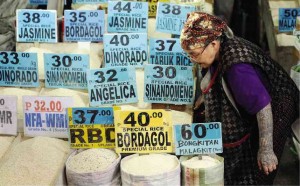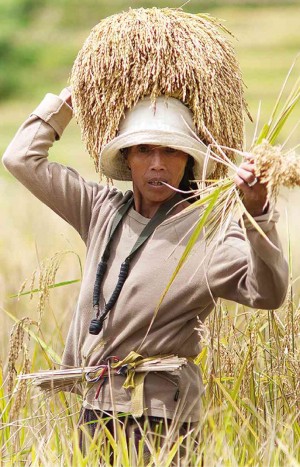Rice farming defines hope of PH farmers
The calloused hands of Wilfredo Bernardo, 43, have been helping feed the country for 15 years.
Tilling an eight-hectare land in the Science City of Muñoz in Nueva Ecija province has been a backbreaking, risky and expensive work but Bernardo has no choice. He needs to put extra hours in his rice farm, two hectares of which he owns and the rest he leases, to put food on his family’s table.
“Rice farming is difficult. It needs big capital, is risky and the margin of profit is only small,” says Bernardo, who belongs to a family of farmers. “I have to be patient, I have to endure and I have to work harder for my family’s needs for subsistence.”
He has been leasing six hectares of land at P250,000 to P350,000 plus 15 cavans of palay per hectare per cropping reason.
“I was lucky this last cropping season that my harvest was bought at P19 to P22 a kilogram, that’s why my income was comparatively good,” Bernardo says.
He attributes the comparatively high buying prices offered by traders to the low harvest of a big number of farmers in Nueva Ecija, owing to the destruction wrought by Typhoon “Santi” in October last year.
During times of normalcy when the harvest is good but traders offer a low purchasing price, Bernardo says he could hardly make a profit of P30,000 a hectare during the wet season and P40,000 to P45,000 a hectare during the dry season.
A cropping season for a farmer is from three to three-and-a-half months. Work involves land preparation, growing the seedlings, transplanting, applying fertilizers and insecticides or pesticides, irrigation, harvesting, threshing, hauling and selling.
“My expenses reach P25,000 to P30,000 a hectare. I have to give a share of 10 percent to my helper and so my income is just about that,” Bernardo says.
Rice farming, he adds, is also subject to the mercy of nature and man.
“When there is no typhoon that affects the standing rice crop, the harvest is good, but when there is a strong typhoon, it is really bad for us. Also, we are at the mercy of rice traders who dictate the buying price [of palay] instead of us dictating the price of our commodity,” he says.
Bernardo’s experience in rice farming is shared by thousands of other rice farmers in the country. It is no wonder that while they feed the nation, it is in this sector that the poorest of the poor in the country are found.
Palay production shortfall
Season after season, the production of unhusked rice (palay) has always been deficient, Department of Agriculture (DA) officials say.
Thus, to fill the gap between supply and demand, the government resorts to rice importation, which places the Philippines in the league of rice importing countries despite its being predominantly agricultural.
But if there is one dream that the country wishes to achieve, that is rice self-sufficiency.
“We are almost there,” says Assistant Agriculture Secretary Dante Delima, who has been designated national rice program coordinator.

A RICE STALL at the Baguio City public market offers different varieties of rice from lowland and upland farms. EV ESPIRITU
“We are already 97 percent self-sufficient and that means we are self-sufficient for the consumption needs of our people. However, we need to have a surplus for the 90-day buffer stock,” he says.
Delima says he believes that the 19.03 million metric tons (MT) of target harvest for 2013, from the 18.03 million MT harvest in 2012, would enable DA officials to claim that the country has reached its goal of rice self-sufficiency.
This optimism, shared by Agriculture Secretary Proceso Alcala, who earlier announced that the country would achieve rice self-sufficiency, is heralded in the slogan adopted in the celebration of the “Year of Rice” in 2013.
The program’s slogan reads: “Sapat na bigas, kaya ng ‘Pinas.”
The 2013 National Year of Rice, which President Aquino proclaimed in October 2012, is also aimed at promoting responsible rice consumption and productive farming through the promotion of efficient rice technologies.
Target reset
But then, strong typhoons in the last quarter of 2013 shot down that optimism. In a statement he released after assessing the damage wrought by Typhoons Santi and Supertyphoon “Yolanda,” Delima says the timetable in attaining rice self-sufficiency has been reset.
“Our target [production] has now been placed at 95 to 97 percent,” he says.
Despite the destruction wrought by Santi to rice farms in Central Luzon, the region can still top its harvest of 3,220,607 MT in 2012.
Andrew Villacorta, DA director in Central Luzon, says the region lost about 250,000 MT of rice to Santi but he is hopeful that it can attain the 3.4 million MT target harvest at the end of the current dry season cropping. Normally, he says, the dry season cropping yields higher harvest.
The region has a rice sufficiency level of 138 percent and is contributing 18 percent to the country’s annual rice production.
Delima says irrigation facilities and other farm infrastructures were destroyed by the
typhoons. The DA, he says, needs an additional P6 billion to its P69.47-billion agency budget to fund the rehabilitation of these facilities.
Eufemio Rasco Jr., executive director of the Philippine Rice Research Institute (PhilRice), says per capita rice consumption of Filipinos has been placed at 119 kilograms a year when it used to be 106 kg in 2000. This, he says, is equivalent to five cups of rice per person a day.
Scientific consumption
“We are advocating for a scientific consumption of rice not only for ensuring a steady supply of this staple but for healthful benefits,” he says.
He says high rice consumption is normally associated with families who lack the means to add other healthy food in their diet like milk, meat, vegetables and fruits, among others.
But Rasco, citing figures from a 2008 survey by the Food and Nutrition Research Institute (FNRI), says each Filipino wastes an average of two spoonfuls of cooked rice or nine grams of raw grains.
Equivalent to 13 percent of the total rice imports in 2010, the rice wastage amounts to P6.2 billion, he says, citing figures from the PhilRice’s Philippine Rice Industry Primer Series.
He says these wasted grains could have fed 2.6 million Filipinos.
Better yield for Pangasinan
But 2013 had been a good year for Pangasinan farmers, according to records of the
Office of the Provincial Agriculturist (OPAg).
Despite the erratic rainfall pattern, rice production is projected to increase from 1.13 million MT in 2012 to 1.14 million MT in 2013, allowing Pangasinan to hold on to its spot as third rice-producing province in the country, next to Nueva Ecija and Isabela provinces.
“Besides, no major calamity hit the province this year that could have destroyed the crops,” says Nestor Batalla, OPAg rice program coordinator. “We have been consistently improving in our rice production.”
He says the average yield for every hectare in the province in 2013 was 4.52 MT, slightly higher than the 4.5 MT in 2012.
“This is because more farmers are now using high-yielding rice varieties, such as certified, hybrid and good seeds,” Batalla says.
Based on OPAg records, hybrid seeds planted in irrigated and rain-fed farms this year had an average yield of 5.86 MT for
every hectare, certified seeds had 4.71 MT per hectare and good seeds produced an average of 4 MT per hectare.
The province has an irrigated area of 167,389 ha and a rain-fed area of 80,146.28 ha.
Batalla says to encourage farmers to plant high-yielding rice varieties, the provincial government subsidized the production of certified seeds in 2011 and distributed these to farmers at half the commercial price.
He says some farmers in irrigated and nonirrigated areas were not able to plant on time because of the late release of irrigation water from the San Roque Dam in San Manuel town and the late rainfall.
As a result, he says, farmers in some 1,496 ha of irrigated areas were only able to plant in December. They will harvest in February or March.
“In areas where farmers are used to early planting, like in western Pangasinan, some of them replanted old seedlings while others had to produce seedlings again,” Batalla says.
He says the habagat (southwest monsoon) that dumped rains and flooded rice fields in Isabela and Nueva Ecija, incurred minimal damage in Pangasinan.
“We had only about 1,328 hectares of rice land affected by the habagat,” he says.
Batalla says with at least half of the total area of the rice farms in the province still relying on the rain, Pangasinan’s rice production this year will not increase much.
“Our only hope is to have more irrigated areas because with irrigation, farmers can plant rice year-round,” he says.
He says the province’s rice production is more than enough for the consumption of its more than 2.7 million people. “Actually, our rice sufficiency was 207 percent in 2012. We don’t have the figure for 2013 yet, but I’m sure it will be higher,” he says.
